Are you planning a trip to Vietnam? Maybe you need to prepare a lot of things like clothes, shoes, and some options for the perfect journey.
And, the basic understanding of Vietnam currency or Vietnamese dong (VND) is certainly one thing you need to prepare to travel to this charming country.
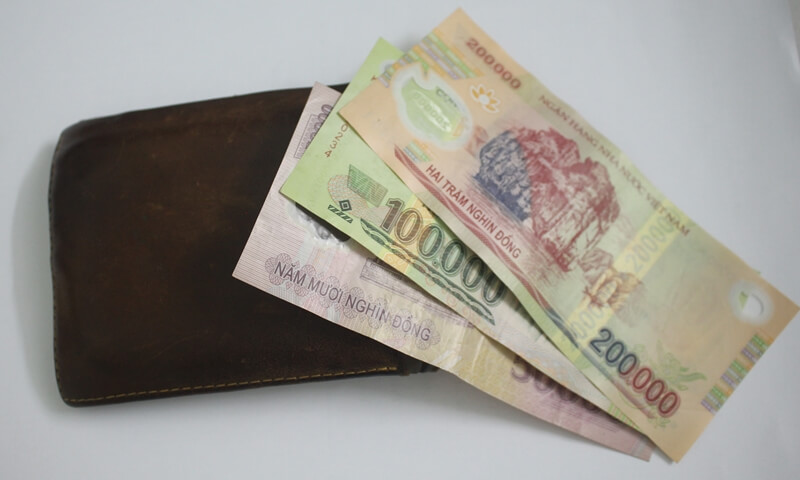
Preferred payment method in Vietnam
In Vietnam, cash is used frequently and widely. It is is the most popular preferred payment method for all types of transactions, and services.
You can easily use cash to buy any items or pay for many kinds of services anywhere.
Therefore, it is much more difficult if you think you only need to pay for everything with credit cards, bank transfers, or international payment accounts in Vietnam.
Using cash becomes a habit which is still gaining the favor of Vietnamese people beyond any other forms of payment.
Thus, you have to use Vietnam Dong if you want to travel here.
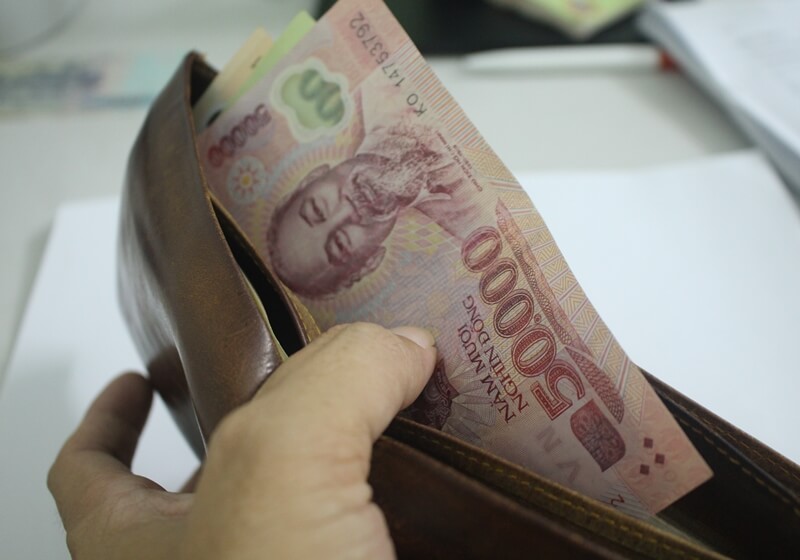
VND exchange rate compared to other currencies
In Vietnam, the foreign exchange rate also changes up and down according to the market and the general fluctuations of the world situation.
However, these fluctuations are always within a specific range allowed by the government.
Therefore, before visiting Vietnam, tourists should learn a little about the exchange rate to ensure that they have prepared enough currency for the trip, avoiding carrying too much or shortening the estimated fund.
The current exchange rate of Vietnamese Dong to some other currencies in the world is listed:
Choose a currency code, then enter number to convert into Vietnam Dong:
- 1USD ≈ 24,400 VND
- 1AUD ≈ 15,700 VND
- 1CAD ≈ 17,700 VND
- 1EUR ≈ 26,000 VND
- 1GBP ≈ 30,400 VND
- 1SGD ≈ 17,800 VND
The exchange rate is rounded to easy to remember, and the local people also prefer that level when counting to change foreign money into Vietnam Dong. Please check the correct exchange rate here. This rate applies to direct cash exchange at the banks and does not include exchange fees that may be available at certain banks.
Where to change your money into Dong?
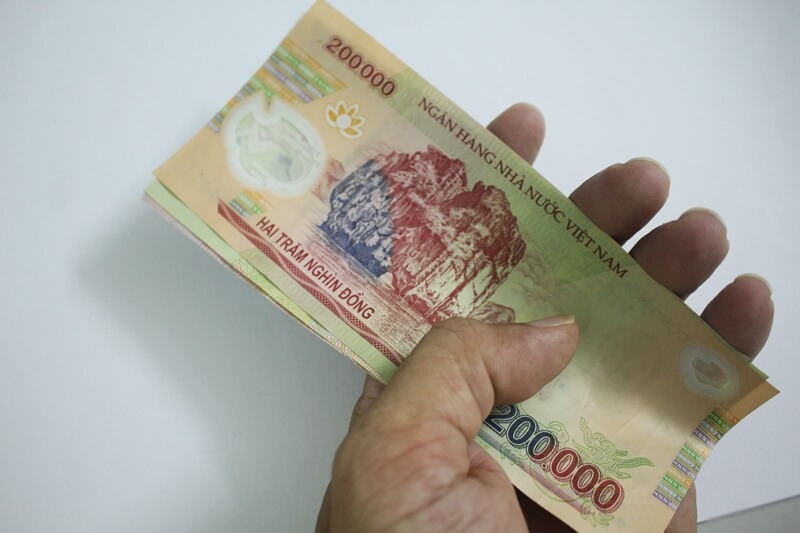
In Vietnam, the government regulates the exchange of foreign currencies to be conducted only at licensed establishments.
At the same time, all trading activities taking place in Vietnamese territory must be managed in Vietnam Dong.
Therefore, to be sure to avoid unintended troubles such as too low exchange rates, illegal exchange of foreign currencies of business establishments, losing high fees and unreasonable fees, visitors should choose to go to banks or bank branches to change foreign money into Vietnam Dong.
It’s not too difficult to find a bank or bank branch in all cities of Vietnam.
Here are the good banks in Vietnam to exchange your money into VND:
- Vietnam Joint Stock Commercial Bank for Foreign Trade – Vietcombank;
- Vietnam Joint Stock Commercial Bank for Industry and Trade – Vietinbank;
- Vietnam Joint Stock Commercial Bank for Investment and Development – BIDV;
- Asia Commercial Joint Stock Bank – ACB.
However, you will not be able to find any of these banks that operates on Saturdays and Sundays. Therefore, if your vacation falls on a Vietnamese weekend, you need to prepare in advance.
At Vietnam’s international airports like Tan Son Nhat in Ho Chi Minh City, Noi Bai in Hanoi, and Da Nang Airport in Da Nang, you will recognize several bank branches to serve money exchange demand of tourists.
And good advice is given to you that if you have not prepared the Vietnamese money earlier, you should convert your money into VND immediately before stepping out of the airport, or using any services.
This helps you avoid having some minor problems when your own currency is not accepted in Vietnam, but you need to buy something right away.
Existing denominations of Vietnam currency
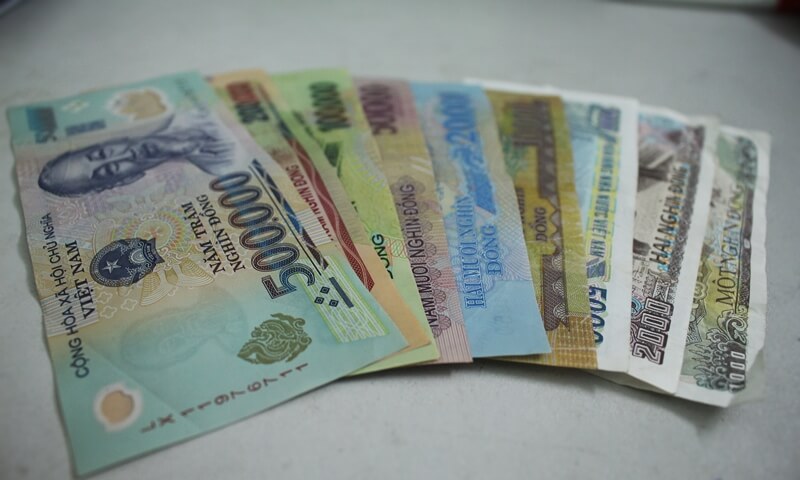
Before 2003, there existed only money in Vietnam made from cotton paper with par value from 100 VND to 100,000 VND.
Since 2003, the government has released more polymer notes, zinc coins (metal coins) and cotton-paper money notes. At the same time, the face value of the currency is now issued from 100 VND to 500,000 VND.
Vietnamese dong coins have five denominations, including 200VND, 500VND, 1000VND, 2000VND, and 5000VND.
However, coins quickly reveal their weaknesses, such as heavy and hard-to-store, while automated trading machines using coins had not yet been widespread in Vietnam.
By 2011, the government decided to stop issuing coins even though it is proper to pay in the market.
Nowadays, Vietnamese money has cotton-paper and polymer notes that are the two types of banknotes being circulated in Vietnam.
Now we will check one-by-one types of Vietnamese dong notes.
1. Par value of 100 VND
This is the smallest denomination of the current Vietnamese currency. Printed on cotton paper, dark brown.
This denomination is now almost invisible in the market, except that some individuals want to use it as a souvenir, because of its small value.
With 100 VND, the user definitely cannot buy anything.
2. Face value of 200 VND
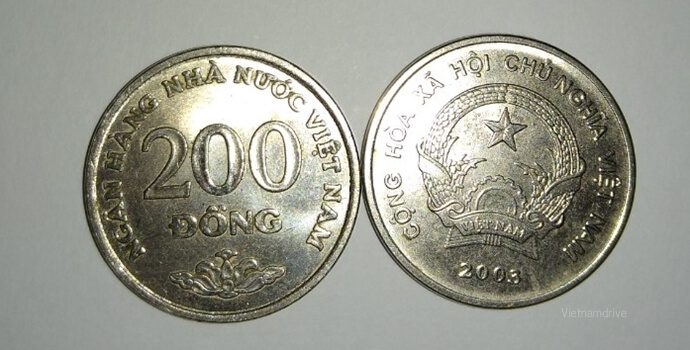
This par value is ranked as the second smallest one in the Vietnamese Dong system.
Printing on two types of materials are red-brown cotton notes and metal coins.
Sharing the same fate with the face value of 100 VND, the 200 VND is also very little in the market.
Only 200 VND is nearly no value to use in Vietnam.
3. Par value of 500 VND
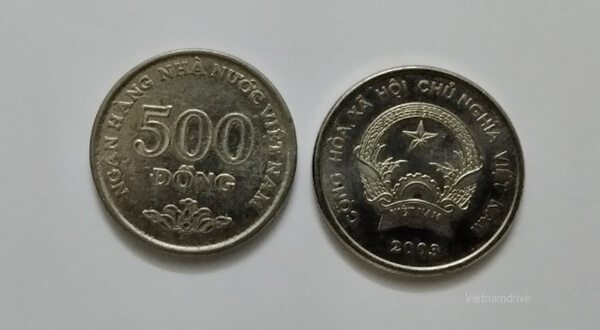
Also printed on two types of material: red lotus cotton paper notes and metal coins.
Currently, in the market, cotton paper par value of 500 VND appears more often than its sister’s metal note.
However, if it’s only for 500 VND, it’s hard for you to buy something. The 500 VND seems to be useful in some shopping centers in Vietnam when they need to return the excess money to customers.
Of course, in small shops and becauce of the market culture of the Vietnamese, many people often ignore the excess of 500 Dong because of its little value.
Tips to know the local habit: When you buy any items, and the excess money is from under 500 VND, you should not wish to get an exchange and request for this quantity.You should ignore them. It is challenging to have some of them nowadays because of no value. Thus, sellers sometimes can give you a small candy instead of this little excess money. And, buyers should do not think the salespeople are not faithful.
4. Face value of 1,000 VND
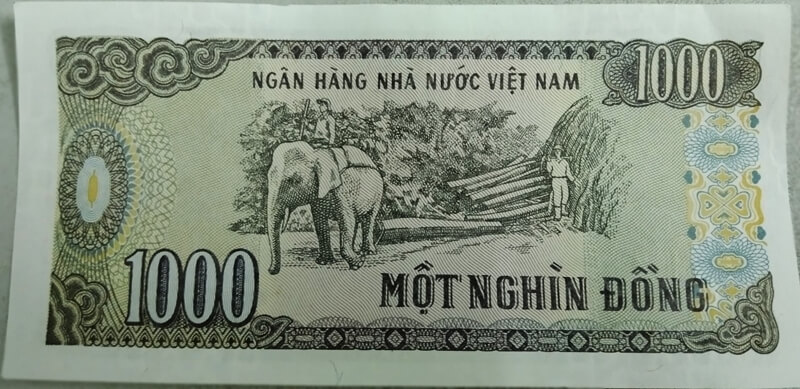
You can start buying a small piece of Vietnamese candy with 1,000 VND. This par value is made from two types of purple cotton paper and metal coins.
Like other denominated coins, a 1,000 VND coin is not suitable for Vietnamese usage habits, so it is very uncommon.
Although it’s still minimal value, only equivalent to about 0.23 USD, you may ask the seller to return it to you.
That also means, in some situations, you cannot buy goods when you do not have enough 1,000 VND.
5. Par value of 2,000 VND
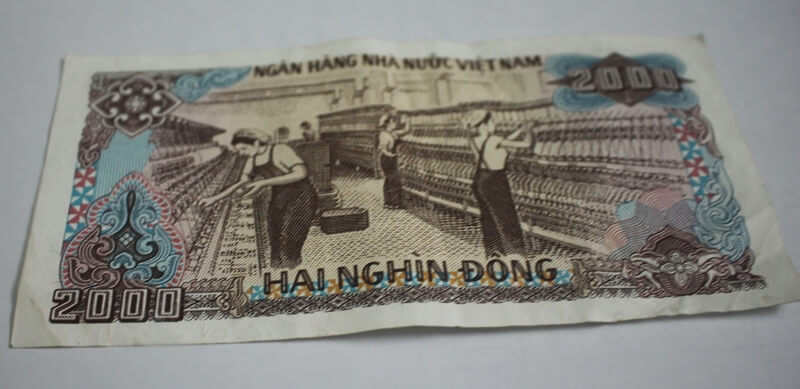
2,000 Dong appears on two kinds of material: dark brown cotton paper and metal coin.
In some parts of Vietnam, you can use a 2,000 Dong cotton banknote in exchange for a small bread that doesn’t add anything else or a mint-flavored gum.
And, of course, there are not too many things that cost about 2,000 VND.
6. Par value of 5,000 VND
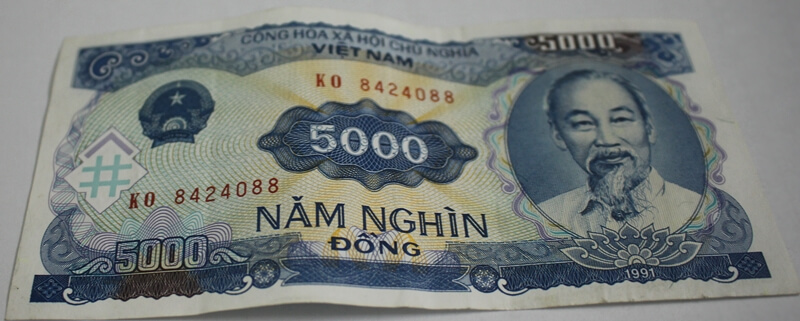
Since 2003, the Vietnamese government has issued this par value on both dark blue cotton papers and metal coins.
Until now, the par value of 5,000 Dong is only popular with the notes of cotton-paper material.
This is also the biggest denomination printed on this material. With 5,000 VND, you can buy 500ml mineral water bottle, a pack of instant Vietnamese noodles, or 2 bananas.
However, there are still not too many options for 5,000 VND in Vietnam market.
Tip for tipping: When you want to tip a worker at the restaurants, hotels or other places, 5,000 VND is the smallest quantity which you should leave as a tip to show your respect. But, it is better to tip some short service or easy help from 10,000VND = 0,43 USD.
7. Par value of 10,000 VND
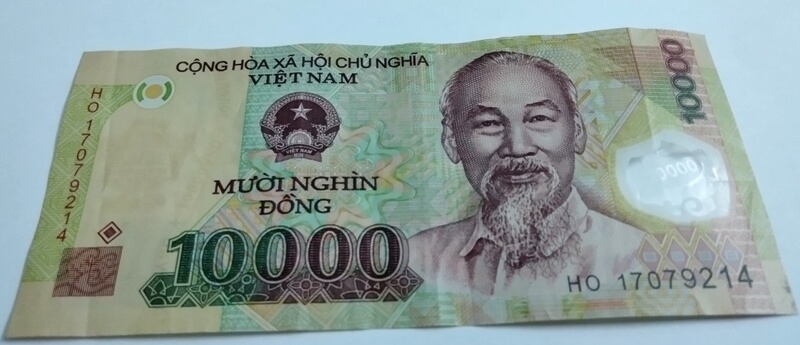
The smallest par value has issued on polymer material, dark brown on a green-gold background.
This is a polymer note with a small size and much shorter than all the remaining polymer banknotes in the Vietnamese money system.
It’s quite easy for you to distinguish it from other polymer denominations. The converted value at present in Vietnam territory is about 0.43 USD for 10,000 VND.
If you want to buy something with 10,000 VND, you can think of a black coffee cup sold on the sidewalk.
Occasionally, you’ll come across an egg sandwich or simple Vietnamese bread with pork that costs 10,000 VND = 0.43$. A local beer can or a 300ml coca bottle selling at a shop also costs around 10,000 VND.
8. Face value of 20,000 VND
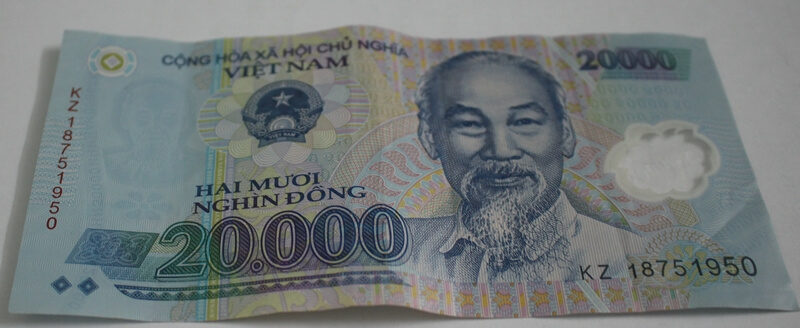
It’s time you need to pay attention because this face value is easily confused with a note of 500,000VND, which has many times higher than 20,000VND.
The par value of 20,000 VND is established on dark blue polymer material while 500,000 VND note is dark blue.
Both have the same width of 65mm, and lengths are 136mm and 152mm respectively.
Many Vietnamese people often confuse these two denominations. In particular, if you have to use money in dim lighting or a hurry, you need to be careful because it’s a pity if you pay a beer costing 20,000 VND for 500,000 VND without getting back the excess.
Of course, with two denominations, the number representing the value of each note is clearly printed on both sides. So, you need to pay attention to these things. That is is the only natural way to avoid confusion.
In most restaurants in Vietnam, it is hard to order a dish for 20,000 VND. But 20,000 VND can be a reasonable “tip” for restaurant servers if you want to thank them.
9. Face value of 50,000 VND
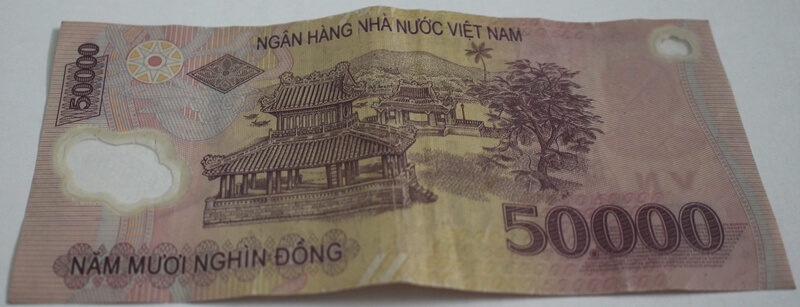
50,000 Dong is a polymer coin with purple-brown color, size 140mm x 65mm. Exchange is equivalent to 2.15 USD for 50,000 VND.
In Vietnam, it is feasible to have a relatively full lunch for 50,000 VND. It includes a wide range of options, such as popular rice dishes, pho, and noodles with one small drink or water sold in small local eateries.
However, if you choose a tourist standard restaurant, it will not be easy to find something on the menu costing less than or equal to 50,000 VND, except for some local soft drinks or beer.
Of course, with 50,000 VND, you can have more options to go shopping, such as some pretty small souvenir products, funny cloth bags, souvenir T-shirts, and lots of Vietnamese fruits with a lower price under 50,000 VND per 1kg.
The 50,000 dong note is rarely confused with other units. However, some believe that it is relatively similar to the polymer banknote of 200,000 VND.
So, if you are still not used to using Vietnamese currency, please pay a little attention to the number that is printed quite clearly on each note.
10. Face value of 100,000 VND
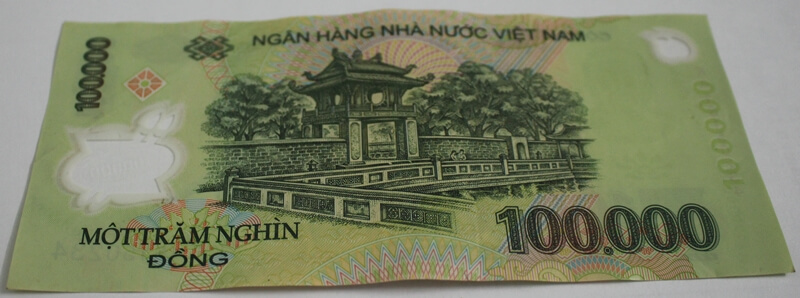
100,000 Dong has a dark green color and is made from a high-strength polymer material.
Both sides of the banknote are printed in par value of 100,000 in numbers and words quite clearly. Currently, the converted cost is about: 100,000 VND ≈ 4.30USD.
With 100,000 VND, what can you buy in Vietnam? Although you can not get a sumptuous meal at the restaurant, many dishes have started to appear in the menu with the price equivalent to 100,000 VND for customers to choose.
A moderate set at 100,000 Dong at fried chicken shops is not hard to find. 100,000 dong = 4.3 USD is also enough for visitors to experience 30 minutes of foot massage or enjoy shampoo and manicure service in Vietnam.
And if you feel the driver has served you all day, it is worth thanking him. The 100,000 VND tip is enough for him to understand that you are happy and grateful to him.
11. Face value of 200,000 VND
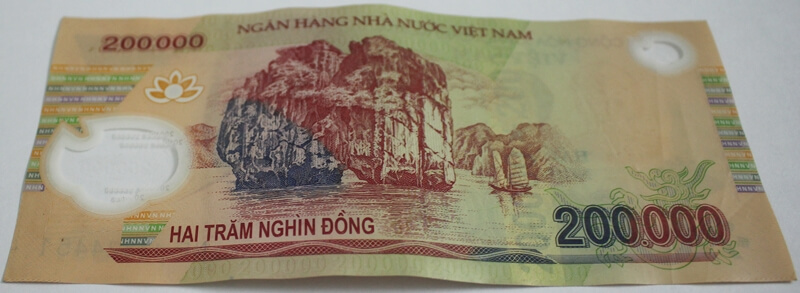
This is the second-largest face value in the system of Vietnamese dong. This note is printed on durable polymer material with red-brown color.
Some argue that it is relatively similar to the polymer banknote of 50,000 VND having purple-brown color.
However, very few Vietnamese encounter confusion between these two denominations. 200,000VND is equal to 8.6 USD.
200,000 dong starts enough for you to have a not-too-fussy meal at a few good standard restaurants.
In case you need to travel by taxi, VND 200,000 is enough for a one-way street with the length from 11km to 13km.
And, this quantity is to say thank you to your guide after a day of his/her enthusiastic work.
12. Par value of 500,000 VND

The highest denomination in Vietnamese currency notes is 500,000 VND, which is printed on the polymer with dark blue color and size 152mm x 65mm.
Converting 500,000 Vietnamese Dong to USD is equivalent to 20.5 USD at the current exchange rate on February 27, 2024.
This banknote’s color is easily confused with much lower denominations: 20,000 VND. So, if you are still not good at using Vietnamese currency, you should pay extra attention when using two par values of 20,000 VND and 500,000 VND. It is better to keep each type of these notes in separate places.
High denominated notes of 500,000 VND are often created for the convenience of storage in personal walets or large payouts.
The recipient will feel satisfied if you pay for the hotel, dinner at a restaurant, or a local tour program with big denominated money.
However, it brings a lot of difficulties when a shopper wants to buy some daily necessities.
Troubles can appear when you forget that you are going to the market or a small roadside shop to buy a bottle of mineral water with a 500,000 dong note. You should also not pay taxi drivers on short trips in this currency.
Conclusion
It is challenging to avoid embarrassment when tourists use a completely new currency for the first time.
The differences in characteristics, denominations, and value of notes always bring a surprise to you.
But, it is also certain that it will be one of exciting experiences with your trip to visit beautiful places in Vietnam.
If everything is ready, bring your backpack and enjoy your great vacation in Vietnam.
And, you will surely become a millionaire in Vietnam.
Stay up-to-date on the latest news and insights in Vietnam by following @vietnamdrive on Twitter and @vietnamdrive on Instagram today!
